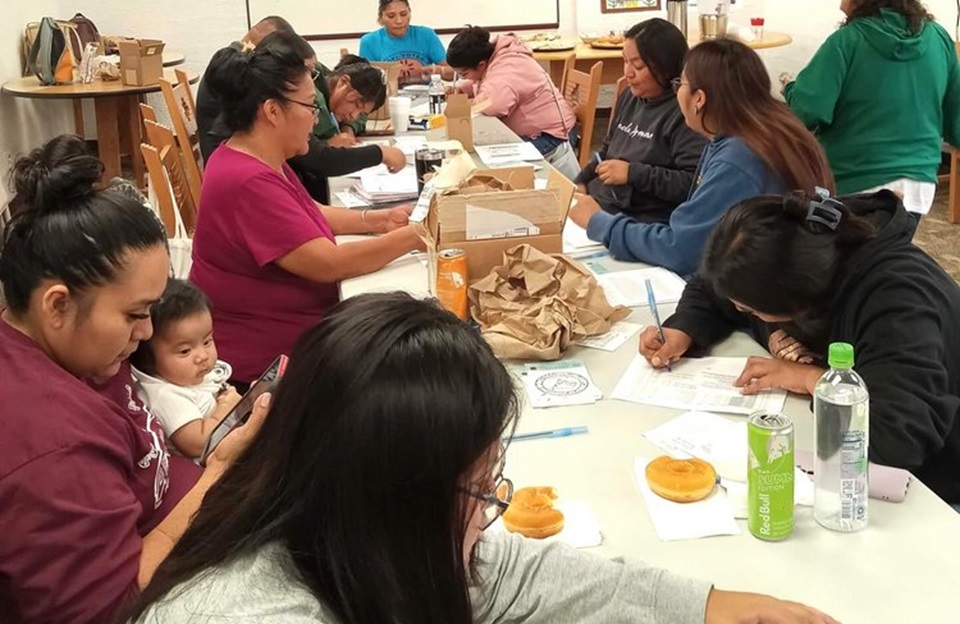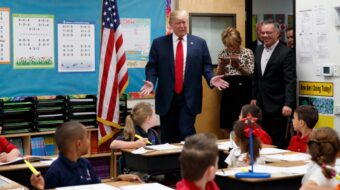
It took Ruben Gallego, Democratic U.S. Senate candidate in Arizona, eight hours at night to hike to the floor of the Grand Canyon to a Havasupai village to meet with Tribal members and win their support.
The village of Supai is only accessible by foot, mule, horse, or helicopter. “You walked in our people’s shoes when you hiked down,” a Tribal council member, Juanita Wescogame, told Gallego.
The Havasupai is one of 22 federally recognized Tribes in Arizona that Gallego is visiting because the 319,000 Native American voters, who make up 5% of the state’s voting population, are critical to the election outcome. President Biden won Arizona by just over 10,000 votes.
To be elected president, Kamala Harris must win the Midwest’ blue wall’ of Wisconsin, Michigan, and Pennsylvania. However, there’s also the ‘Native Wall,’ a formidable force of twelve states, including key battleground states of Arizona, Wisconsin, Nevada, North Carolina, and Michigan. These states, with their large Native American populations, will decide the election outcome.
“They could be the margin in a lot of these razor-thin races here, up and down the ballot, including the presidency,” said Gila River Community Governor Stephen Roe Lewis at a recent meeting of Tribal leaders with Vice Presidential candidate Tim Walz.
With the growing power of Native American voters, GOP-dominated state and county bodies have intensified disenfranchisement, including restrictions on in-person voter registration and early voting, gerrymandering, few voting locations on sovereign lands, and felony disenfranchisement.
Long distances to registration and voting sites, limited internet access, lack of addresses, inadequate postal delivery to remote areas, and poor road infrastructure compound the problem.
These challenges make it extremely difficult to vote. As a result, over 4.7 million Native Americans are eligible to vote, yet only 66% are registered, with an average turnout of 36.4%. Over 1 million Native Americans are not registered to vote. Nevertheless, with so much at stake, Native organizations, Tribal governments, and Democrats are unfolding historic GOTV efforts.
In 2020, Joe Biden won 60% of the Native American vote and swept close elections in all those presidential battleground states except North Carolina. In the 2022 midterm elections, Native American voters, led by women, supported Democratic candidates with 56% of the vote.
The strong Native American voter turnout for Biden and Democrats in 2020 and 2022 significantly increased Native representation in the Biden administration and Democratic-led state governments, which have promoted pro-Native policies.
“The Biden-Harris administration has demonstrated an unprecedented commitment to Native issues and Tribal sovereignty,” said Judith LeBlanc, Executive Director of Native Organizers Alliance, who praised the administration’s actions, including the appointment of over 80 Native people to high-level positions, the implementation of protections for sacred places, the restoration of Native names to federal geographical locations, the strengthening of voter rights for Native peoples, and the signing of 200 new co-stewardship agreements for federal-Tribal co-management of lands and water.
Tribal-federal co-management of public lands and waters, many located on ancestral homelands of federally recognized Tribes, upholding fishing rights, restoring watersheds within national forests, and maintaining historical resources and national monuments, has grown, especially during the last four years.
Native American activists and tribal leaders are eager to hear the Harris-Walz campaign’s plans to protect Tribal sovereignty and Native rights and build on the Biden-Harris legacy of honoring Nation-to-Nation relationships with Tribes.
Meanwhile, the first Trump administration was a disaster for Tribal nations, including the assault on environmental protection and sacred lands and a horrendous COVID-19 response. “The total onslaught of federal rule rollbacks under environmental laws was like nothing we’ve ever seen. It was dizzying,” said Gussie Lord of the Oneida Nation of Wisconsin.
Trump’s plans for Indian Country contained in Project 2025 are far worse. He aims to transform the Department of Interior, which oversees much of Federal-Tribal cooperation, into a corporate weapon to facilitate the plunder of public lands and water and the extraction of fossil fuels without restraint.
By seizing federal lands for development under the guise of solving the housing crisis, Project 2025 would violate treaties and tribal agreements, undermine Tribal sovereignty, and shatter Federal-Tribal co-management, denying Tribes access to ancestral lands and water.
Meanwhile, Harris has aggressively advanced a pro-Native American agenda. “The relationship between Tribal nations and the U.S. government is sacred, and we must honor Tribal sovereignty, embrace treaty and trust obligations, and ensure Tribal self-determination,” Harris said at a campaign rally in Wisconsin.
As Minnesota Governor, Walz, and Lieutenant Governor Peggy Flanagan, a member of the White Earth Band of Ojibwe, “have the strongest record of collaboration with Tribal governments and Native communities of any gubernatorial administration in the country,” according to LeBlanc. If Harris-Walz wins, Flanagan will become the nation’s first Native American governor.
The Harris-Walz campaign has launched a massive GOTV campaign, including paid canvassers, radio, TV, and digital ads highlighting Harris’ agenda for Indian Country.
Working to turn out the vote
Native American organizations and Tribal governments are working intensely to turn out the vote. NativeVotes2024, a collaboration between Native Organizers Alliance and IlumiNative, is working with Tribal leaders and community groups, putting 200 “moccasins” on the ground in Alaska, Arizona, Michigan, Minnesota, Montana, Nevada, New Mexico, North Carolina, Oklahoma, South Dakota, Washington, and Wisconsin.
The Native American Rights Fund and Four Directions, which partners with leading voting rights organizations, including the Lawyers’ Committee for Civil Rights Under Law, the American Civil Liberties Union Voting Rights Project, and the National Congress of American Indians, are working to expand and protect the vote across Indian Country.
In Nevada, the Native American population comprises 28 Indigenous nations, bands, and colonies and totals 70,000 members, nearly twice the 33,000 margin Joe Biden won the state by in 2020.
Tribal communities use the state’s digital absentee voting system to broaden ballot access in remote parts of Nevada. Historically, voting obstacles included a lack of polling locations and unreliable mail service.
Approximately 91,000 Native Americans (147,000 total population) of voting age living in Wisconsin, 1 – 2% of the population. In 2020, Joe Biden won the state by 20,000 votes, and the race is a dead heat this year.
In Michigan, there are 242,000 Native Americans in 12 federally recognized with concentrated populations in Detroit, Lansing, and Grand Rapids. Biden won Michigan in 2020 with 150,000 votes, and polls show the race is a tossup.
The race for U.S. Senate in Montana could determine Democratic control. Montana has 70,000 Native Americans, comprising 7% of the state’s population. Democratic incumbent Jon Tester has a long history with Native Americans whose votes were decisive in his two previous elections. Tester’s opponent is GOP extremist candidate Tim Sheehy, who has made multiple racist remarks about leaders of the Crow Nation.
“Indian Country is facing tough battles in 2024, and the outcome of this election couldn’t be more important,” said Blackfoot tribal member Cinda Burd Ironmaker, the Native vote political director for the Montana Democratic Party who heads Big Sky Victory.
Native American groups have hired 50 organizers and opened 20 offices, many on reservations and tribal communities, and are conducting outreach in tribal languages.
Harris and Democrat’s top legislative priority will be the passage of a fully restored Voting Rights Act. Additionally, enactment of the Native American Voting Rights Act is essential to address historic and specific voter disenfranchisement among Native Americans, according to Jaqueline De León of the Native American Rights Fund.
The Act is needed “to set federal minimum standards that require on reservation equitable registration, early voting, and poll opportunities,” said De León. “The attacks on voting rights are relentless, and Native Americans are at the heart of those claims. Native Americans hold tremendous power and can swing the presidential election if given a fair opportunity to vote.”
We hope you appreciated this article. At People’s World, we believe news and information should be free and accessible to all, but we need your help. Our journalism is free of corporate influence and paywalls because we are totally reader-supported. Only you, our readers and supporters, make this possible. If you enjoy reading People’s World and the stories we bring you, please support our work by donating or becoming a monthly sustainer today. Thank you!












Comments